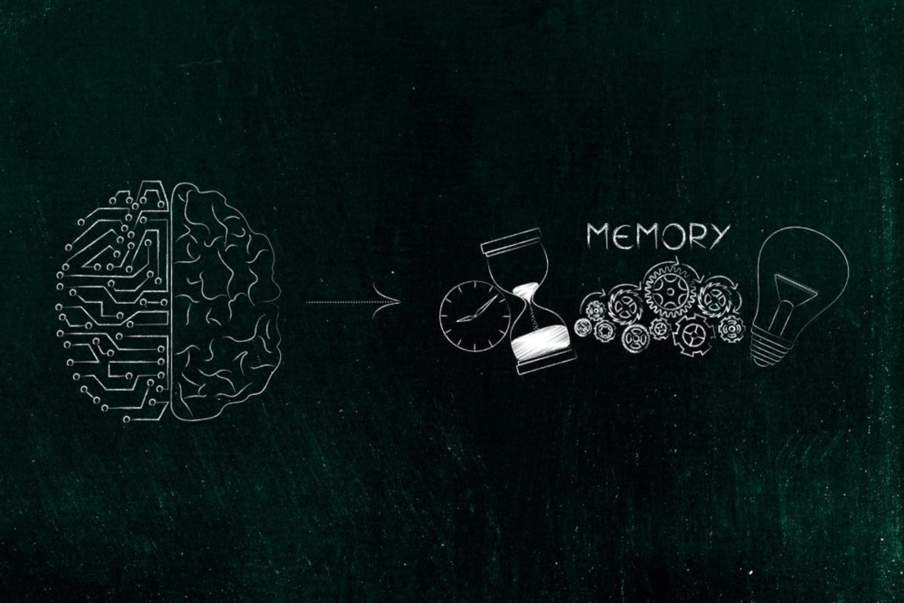Mnemonics in practice

The human brain uses only 10% of its abilities, the rest of the brain's potential remains untouched. A person, who has a good memory and who can memorize a huge amount of incoherent information, does not use any secrets to uncover the remaining 90% of brain abilities.
Practical application of mnemonics
It is enough to train your memory every day for 15-20 minutes. Use proven mnemonics technology to memorize information.
The modern world of computer technology and information requires a huge amount of remembering of accurate information. These can be email passwords, a program's numeric code or a file. In this case, it is simply necessary to memorize and reproduce numeric and alphabetic information accurately.
It also requires memorizing of poems and texts of the school literary program. Poems are a good training for memory, they increase the vocabulary of rhymed words, develop creative abilities.
Having a trained memory, you can learn more than one foreign language in a short time.
Mnemonics technics allow you to increase the amount of new foreign words. After learning French, you can easily use it as a matrix for memorizing words in German or another language.
Some information about the memory mechanism itself
The memory of a person has enough studied boundaries. Psychologists have found out that memory is divided into operating, long-term and short-term. The imprint of the real world enters the short-term memory with sensory receptors of perception (vision, hearing). With the help of focused attention information is captured, recognized and compared in operating memory. In operating memory, as well as in the short-term memory, a limited number of elements is stored, seven plus or minus two elements for 30 seconds.
Then the information is encoded into cognitive structures (meaning) or subjected to transcoding and sent to long-term memory, where it is stored all your life.
The better and more efficient the coding of information is, the longer it will be remembered and the faster it will be retrieved from this storage. The content of short-term memory is constantly changing, new elements are replacing the old ones. Temporary erasing of already processed information in the course of thinking is a protective function of the brain from constantly flowing sensory stimuli from the outside world.
If the erasure of old traces of information did not occur, the brain would be very overloaded. And for this reason, the amount of memory never changes. Sometimes overlapping of one information over another occurs, and information is mixed, for example, when browsing different texts continuously. In this case, memory mistakes may occur. The lack of use of one or another learned information leads to its absolute erasure. Often, its mental repetition, on the contrary, leads to constant stimulation of the corresponding neural connections in the brain.
There are various methods of mnemonics, allowing to use all the possibilities of memory effectively.
School methods of memorizing educational material were based on multiple repetitions. Such a mechanical learning took a lot of time with low results. An incomplete understanding of the material led to the fact that it was quickly destroyed and erased in memory. That is why, one of the rules of durable memorizing is the comprehension of memorized information.
Already familiar information, which has some relation to it, contributes to the rapid assimilation of new information. For example, if a person is studying medicine or psychology, then new information about illnesses or mental disorders will fall into the same context nearby. Information is assimilated into the same memory cells as previously mastered knowledge.
Such a rapid assimilation of new information is due to the fact that in our mind there are already ready generalizations - concepts, the necessary set of associations, which others connect to.
Mental factors that contribute to better memorizing and learning
It is necessary to systematize your lessons of memory training. If you are learning a foreign language, repeated classes should not happen with a large gap in time. If you do it two days in a row, and then rest for five days, then the new information will be forgotten and erased from memory faster than a new one will be accumulated. So, the level of memory development will remain low. Therefore, you need to train every day for 15-20 minutes.
For a better understanding of the information, try to organize it into a logical structure like a tree. More general knowledge (word, concept) can be used as a tree trunk, and further on the principle of branches you can grow more specific information. If you learn words, try to combine them into one semantic field. Or according to the degree of abstractness (for example, the founding date of Vologda is 1147 - Vologda, the base, the date, 11 47).
The natural language of our consciousness
Any symbolic language (language of mathematics, language of native speech) is an artificially created communication system. A child who cannot read and write for some time remembers everything with the help of pictures - images. Therefore, image is the most natural thing for human consciousness. This is the best code to remember.
Our consciousness perceives all information in a figurative form. The image of objects, numbers, words appears in our mind much faster than conceptual structures and thinking start to work. A retained image in the memory as a reaction to a stimulus without observing the actual object itself is called a representation.
Thus, memorizing devices for memory are aimed at:
- maximum development of figurative thinking;
- creation of stable supporting associations;
- ncrease in the time of concentration of consciousness (attention).
Attention training
Exercise 1.
Bring the palms of your hands together, leaving between them a distance of 1 centimeter. After some time, a feeling of warmth appears between the palms. Try to concentrate on this sensation, stopping the flow of thoughts. At this moment do not think about anything.
Exercise 2.
Exercise for attention with the help of breathing. Sit comfortably in your chair. Breathing should be smooth and calm. Then try to follow the rhythm of your breathing. Slowly observe the moment of inhalation, exhalation.
Exercise 3.
Another method helps in training attention. It is necessary to concentrate on the whole image of your body. Mentally walk on the body: how your hands are lying and relaxed, what sensations in your legs you have. Try to feel the warmth of your body from head to toe.
Manipulation with images. Basic techniques of mnemonics
The main methods of mnemonics are based on the visualization of stored information. When reading, to memorize all the text, try to make each word into a picture in your imagination. With the help of mental actions try to see the image from all sides. For example, imagine a book. Mentally turn it over. Look what color it is, how thick it is.
Visual images can be interconnected. The connection between them is remembered by the brain, and if necessary, to recall the entire chain of images, it is necessary to recall one of the key. In this case, the brain will react the stimulus giving all the material remembered in the images.
Image overlay method
There is a technique for creating a matrix by overlaying images. A link is created that allows you to recall the weak links between the stimulus and the information that is remembered. This mnemonic technique is used to learn foreign words. In this case, images of different modalities are superimposed - visual and acoustic.
Method of increase and reduction of images
It is necessary to take a more complex image and put there more simple one. A complex image can be reduced if necessary. For example, imagine a thermometer, examine it in detail: division, numbers, mercury column. Increase the mercury column and you can hang a bucket on it. Then all the small parts roll back to normal size.
Method of image transformation
Imaginary objects can also be transformed. Thicken, lengthen. Add different details. This is necessary in order to be able to reuse them.
Mnemonics and memory techniques
Creating artificial associations
Combine several different images into one picture that can be remembered as one element. At the same time you can combine from 3 to 5 images together.
Natural associations
Natural associations are created by the brain in everyday life. All objects that we see in our environment already created a definite connection between themselves. The atmosphere of a well-examined room, or a well-known way from home to work through the park, can become a pivotal association for memorizing the necessary information, putting it on the pieces of furniture. To reproduce this information, you need to remember the familiar place or room.
Symbolization
Symbolization is a method for memorizing abstract words that are difficult to visualize. Use well-known characters:
- the symbol of peace is the dove;
- symbol of death - the skull;
- etc.
To create symbols you can use free associations. Then you can use a generalized image (symbol) for putting smaller and specific associations, increasing the semantic field.
Memorizing numeric information
For this, a ready-made image matrix is prepared in advance.
For example:
• 1 - card;
• 2 - a glass;
• 3 - bird.
But it is more efficient to use a graphic image and similarity with other objects to designate numbers. For example:
• 0 - can be designated as a clock, a globe, which have a round outline resembling a given digit.
• 1 - candle, pencil, nail;
• 2 - swan, chess horse;
• etc.
Eidetic
From the word "eidos" - the image. The basis of this method of memorizing is not only the figurative perception of the world, as in childhood, but also the connection of mental material. The child has more developed curiosity and a sense of surprise to everything new. That is why, particularly new and interesting information stimulates neural connections more.
Events that are accompanied by a sense of joy are remembered most vividly. So, strive to make your associations as interesting as possible.
It is advisable on the basis of memorized material (such as numbers) to come up with an unusual story that brings all artificial associations together.
When memorizing foreign words, try to imagine what sensations this word gives you. The sound of this word. The child remembers all the surrounding information with emotions, internal sensations, and not with logic. Obtaining positive emotions from images is also reflected on the chemical level by the release of the pleasure hormone (endorphin). Material is fixed in the brain structure.
You can supplement your imagination with a drawing, creating what is said in the poem.
Difficult and long words and numbers need to be analytically decomposed. Two-digit numbers can be added getting a new number — a code for storing numbers in memory. For example, in order to memorize a foreign word “окно” (window) it is possible to break it up into ок-но , it turns out in the word "окно" there is also the word "ок". To memorize the number 315, you can get a new number 3 + 1 + 5 = 9, so you need to memorize not three numbers, but one.
In general, the use of mnemonics for the first time will bring some additional mental work, but this is exactly what you need - in the end, you will form those mental images that you can successfully memorize. With time and with improved skills, the use of mnemonics will be easy, and the result will be more guaranteed. As we mentioned above, the key to success is in regular training. Train for success.











